What is managed IT services? And what does “IT staff augmentation” mean? What is the difference between them and how to decide which option is best for your project? That’s exactly what we will talk about below. We will provide detailed answers to these and many other important questions regarding these two forms of software development outsourcing.
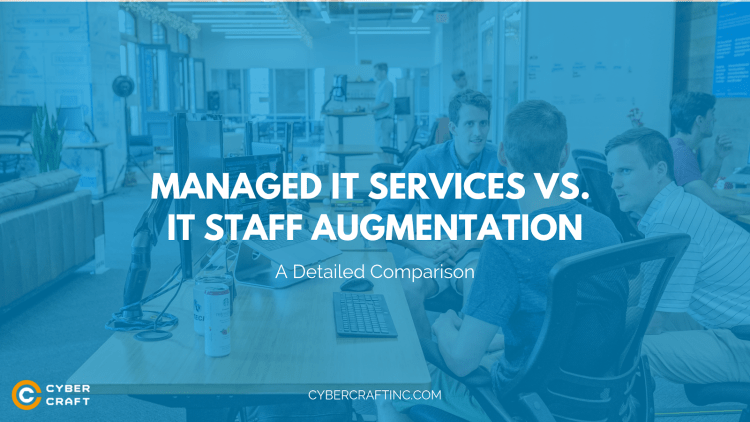
We’ll provide exact definitions for IT staff augmentation services and managed IT solutions. We will also explain in detail how to find the best managed IT service providers or IT staff augmentation companies. Let’s get started!
If you don’t have time to read through our long comparison then here’s the short answer you’ve been looking for. If you don’t have sufficient management resources and know-how (a chief technology officer, project manager, team lead, etc.) in your team then managed IT services may be the right option for you.
Otherwise, if you have people who are capable of managing and leading a development team then simple staff augmentation without including project managers and other management positions on the development company’s side is the right option. If this answer is not sufficient and you’d like to learn more and get a better understanding of both options then keep reading.
As software development outsourcing has become a popular alternative to in-house development, there have appeared numerous outsourcing models. The two most popular models are managed services and staff augmentation. Both have their pros and cons as well as risks. But before we talk about these, let’s start with the definitions.

What Is Managed IT Services? Managed IT Services Definition
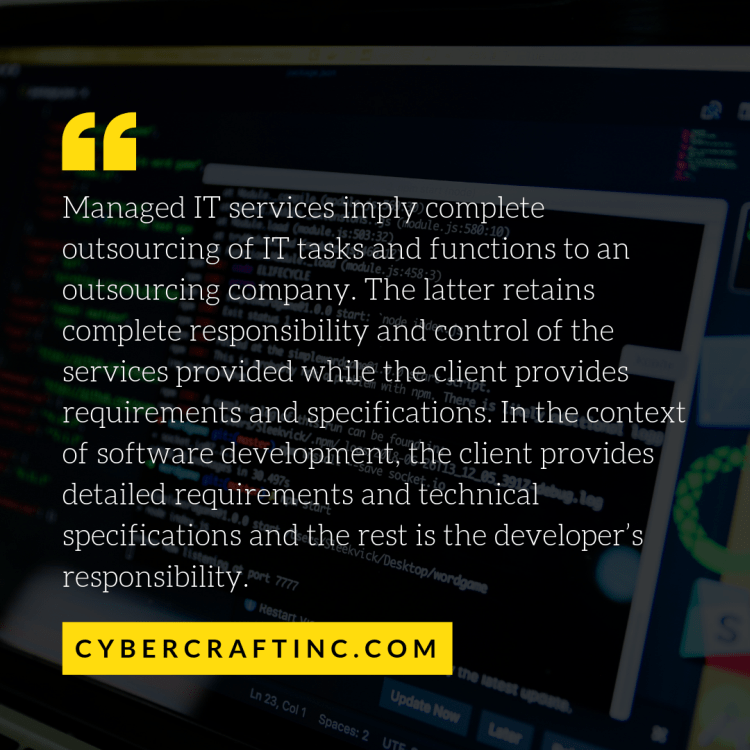
Managed IT services imply complete outsourcing of IT tasks and functions to an outsourcing company. The latter retains complete responsibility and control of the services while the client provides requirements and specifications. In the context of software development, the client provides detailed requirements and technical specifications and the rest is the developer’s responsibility. Every software project requires management work besides coding itself.
Obviously, someone has to do that management work. In the case with managed IT services, the outsourcing firm provides human resources which manage a project: project managers, team leads, analysts, etc. It’s for this reason that they are called “managed services”.
Benefits of Managed IT Services
The nature of this outsourcing model presents the following advantages:
- Saving time
- Access to the best talent
- Focus on your core competencies
- No recruitment headache
- Lower operational & development costs
All of these benefits are not always present in every situation. Everything depends on your specific circumstances and especially the outsourcing company you choose. So let’s analyze each of them in detail.
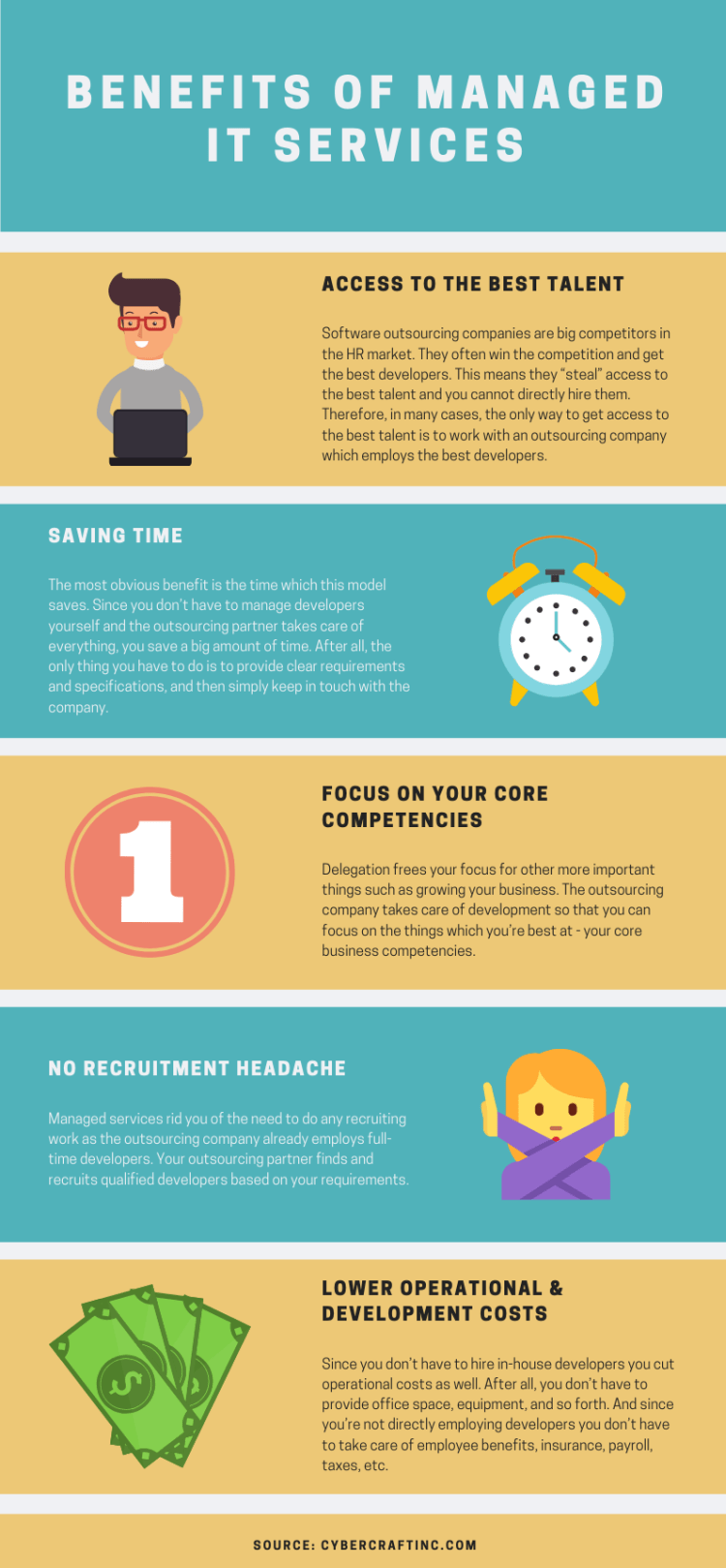
Saving Time
The most obvious benefit is the time which this model saves. Since you don’t have to manage developers yourself and the outsourcing partner takes care of everything, you save a big amount of time. After all, the only thing you have to do is to provide clear requirements and specifications, and then simply keep in touch with the company.
Access to the Best Talent
Software outsourcing companies are big competitors in the HR market. They often win the competition and get the best developers. This means they “steal” access to the best talent and you cannot directly hire them. Therefore, in many cases, the only way to get access to the best talent is to work with an outsourcing company which employs the best developers.
Focus on Your Core Competencies
Delegation frees your focus for other more important things such as growing your business. The outsourcing company takes care of development so that you can focus on the things which you’re best at – your core business competencies.
No Recruitment Headache
Managed services rid you of the need to do any recruiting work as the outsourcing company already employs full-time developers. Your outsourcing partner finds and recruits qualified developers based on your requirements.
Lower Operational & Development Costs
Since you don’t have to hire in-house developers you cut operational costs as well. After all, you don’t have to provide office space, equipment, and so forth. And since you’re not directly employing developers you don’t have to take care of employee benefits, insurance, payroll, taxes, etc.
Managed IT Solutions Disadvantages & Risks
But with the advantages described above there also come certain risks and cons you must be aware of:
- Possible higher costs compared to staff augmentation
- Less control on your side
- Reliability
Let’s analyze each of these in detail.
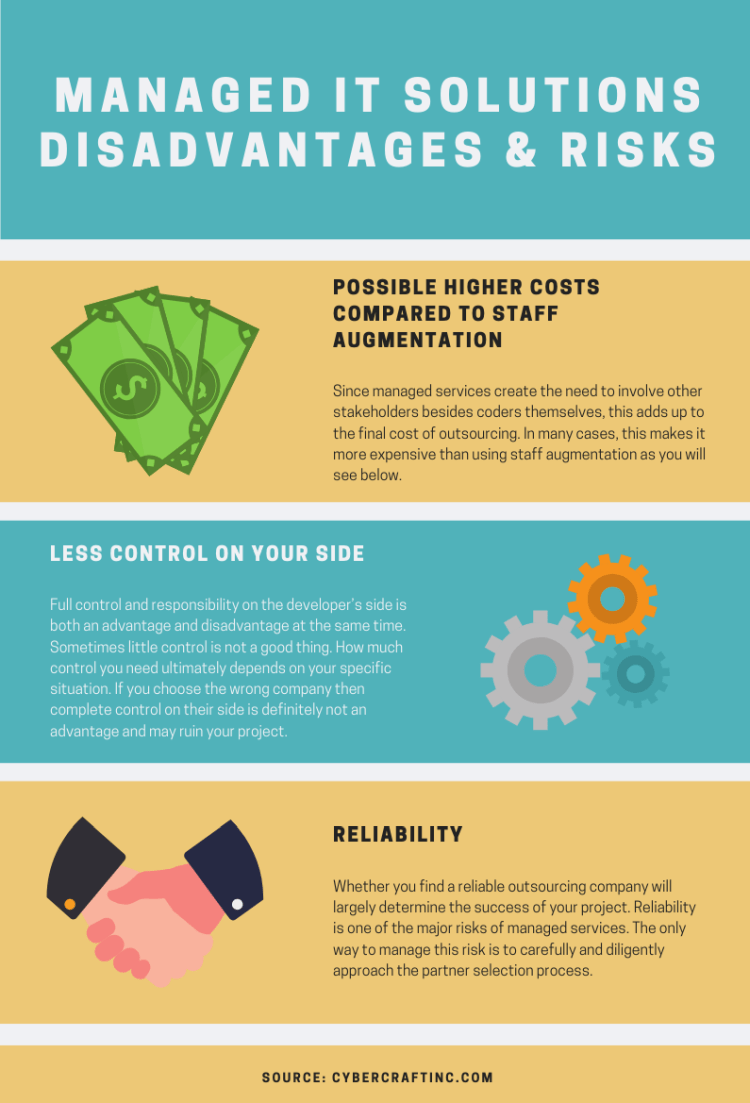
Possible Higher Costs Compared to Staff Augmentation
Since managed services create the need to involve other stakeholders besides coders themselves, this adds up to the final cost of outsourcing. In many cases, this makes it more expensive than using staff augmentation as you will see below.
Less Control on Your Side
Full control and responsibility on the developer’s side is both an advantage and disadvantage at the same time. Sometimes little control is not a good thing. How much control you need ultimately depends on your specific situation. If you choose the wrong company then complete control on their side is definitely not an advantage and may ruin your project.
Reliability
Whether you find a reliable outsourcing company will largely determine the success of your project. Reliability is one of the major risks of managed services. The only way to manage this risk is to carefully and diligently approach the partner selection process.
IT Staff Augmentation Services Definition
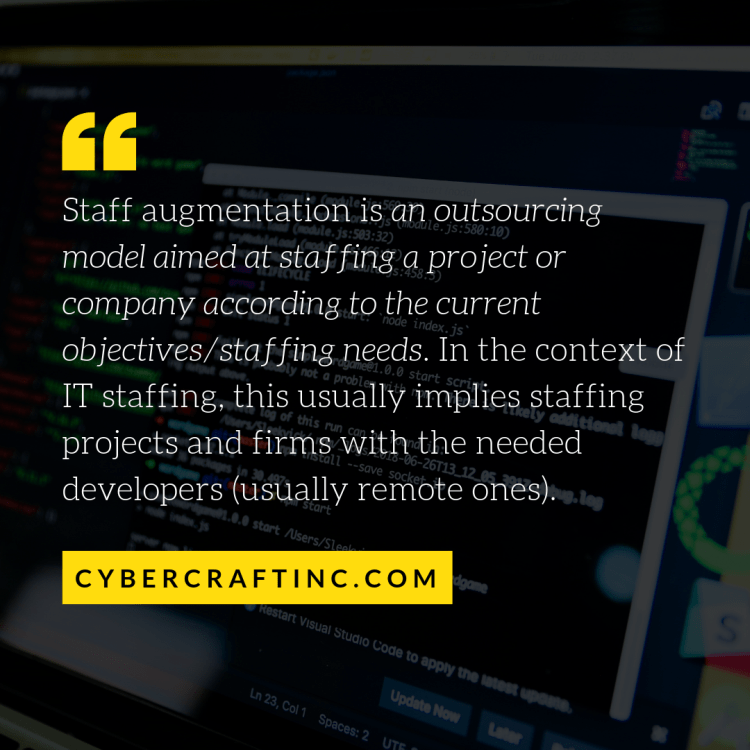
IT staff augmentation implies finding and recruiting the needed human resources for a project or company. In the context of remote software development, this implies providing remote dedicated developers/teams for a project or company.
First, you tell the staffing company whom you need to hire. Then the staffing company finds and recruits the right developers who correspond to your requirements. There is a round of interviews, tests, and screening before you make the final hiring decisions.
Once you approve all the candidacies they become part of your team and your full-time employees. The only difference is that they are based abroad and work at the staffing company’s office. The latter serves as the official employer of your developers and takes care of their salaries, employee benefits, and so forth.
The management of the team is your responsibility. You manage and control the development process and tell developers what to do. However, in many cases, the staffing company may provide you with a team lead, project manager, etc. – everything depends on your needs. You decide on the degree of involvement required from your side.
Advantages of Working with IT Staff Augmentation Companies
Just like managed services, staff augmentation presents significant advantages:
- Less recruitment headache
- Lower operational costs
- Lower development costs
- Less legal headache
- Access to the rare and needed specialists
- Control on your side
Let’s take a look at each in detail.

Less Recruitment Headache
You don’t have to go out there to search for the right team members. The staffing company does that for you. You simply provide detailed requirements and they do the rest.
Lower Operational Costs
You don’t have to provide office space, direct employment, employee benefits, etc. to your remote team members. The staffing company does all of that for you as well.
Lower Development Costs
Just as in the case with managed services, your developers are most likely going to be based abroad. Therefore, the rates and total development costs should be lower as well.
Less Legal Headache
The staffing company carries most of the legal responsibility for the developers as their official employer. Therefore, there is little paperwork and legal headache involved on your side.
Access to the Rare and Sought-After Specialists
Just like managed services, staff augmentation provides you with direct access to the best specialists. With the former, you don’t always have direct access to them or communicate with them directly but with this model, you get direct access.
Control on Your Side
Finally, this model implies direct control on your side. Since you are the one who communicates with the team directly and manages it, you are the one who has the most control.
IT Staff Augmentation Disadvantages & Risks
Staff augmentation is definitely not for everyone. There are certain disadvantages and risks which you must be aware of:
- Management resources are necessary
- Reliability
- Staff deficit
Let’s break them down in detail.
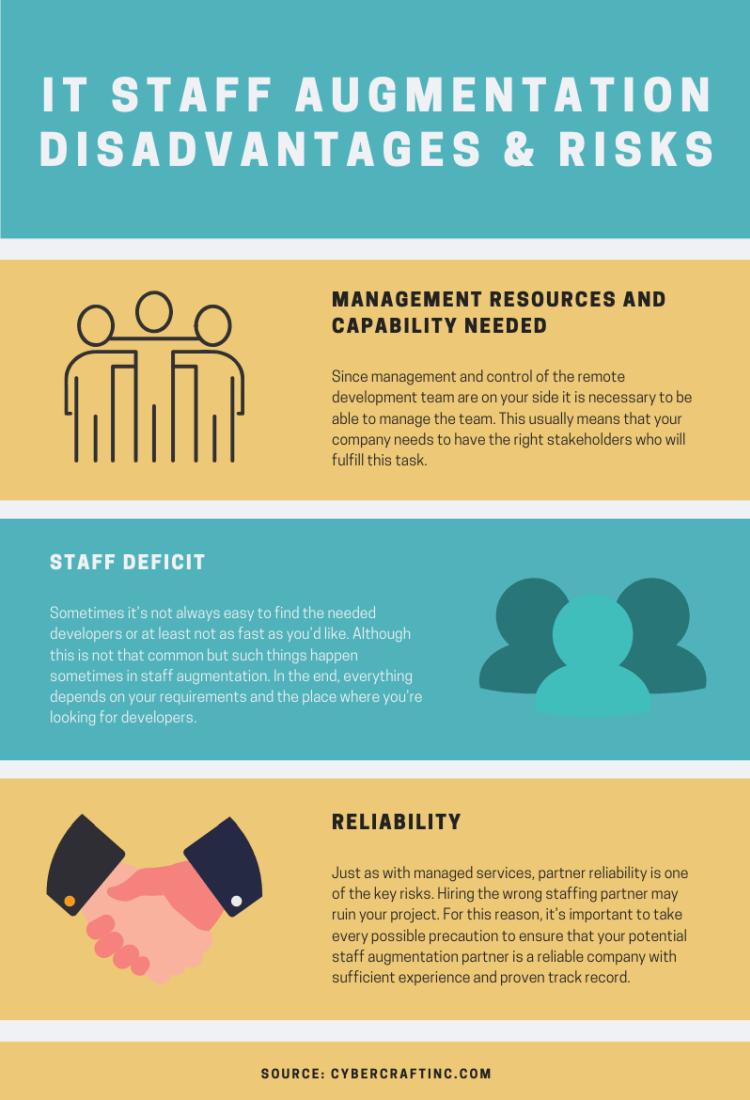
Management Resources and Capability Needed
Since management and control of the remote development team are on your side it is necessary to be able to manage the team. This usually means that your company needs to have the right stakeholders who will fulfill this task.
Reliability
Just as with managed services, partner reliability is one of the key risks. Hiring the wrong staffing partner may ruin your project. For this reason, it’s important to take every possible precaution to ensure that your potential staff augmentation partner is a reliable company with sufficient experience and proven track record.
Staff Deficit
Sometimes it’s not always easy to find the needed developers or at least not as fast as you’d like. Although this is not that common but such things happen sometimes in staff augmentation. In the end, everything depends on your requirements and the place where you’re looking for developers.
So now having reviewed the advantages and disadvantages of both options let’s talk about how to find the right managed IT services and staff augmentation partner.
How to Hire the Best Managed IT Services or IT Staff Augmentation Company
There are a few things you have to take into account when reviewing a potential managed services partner:
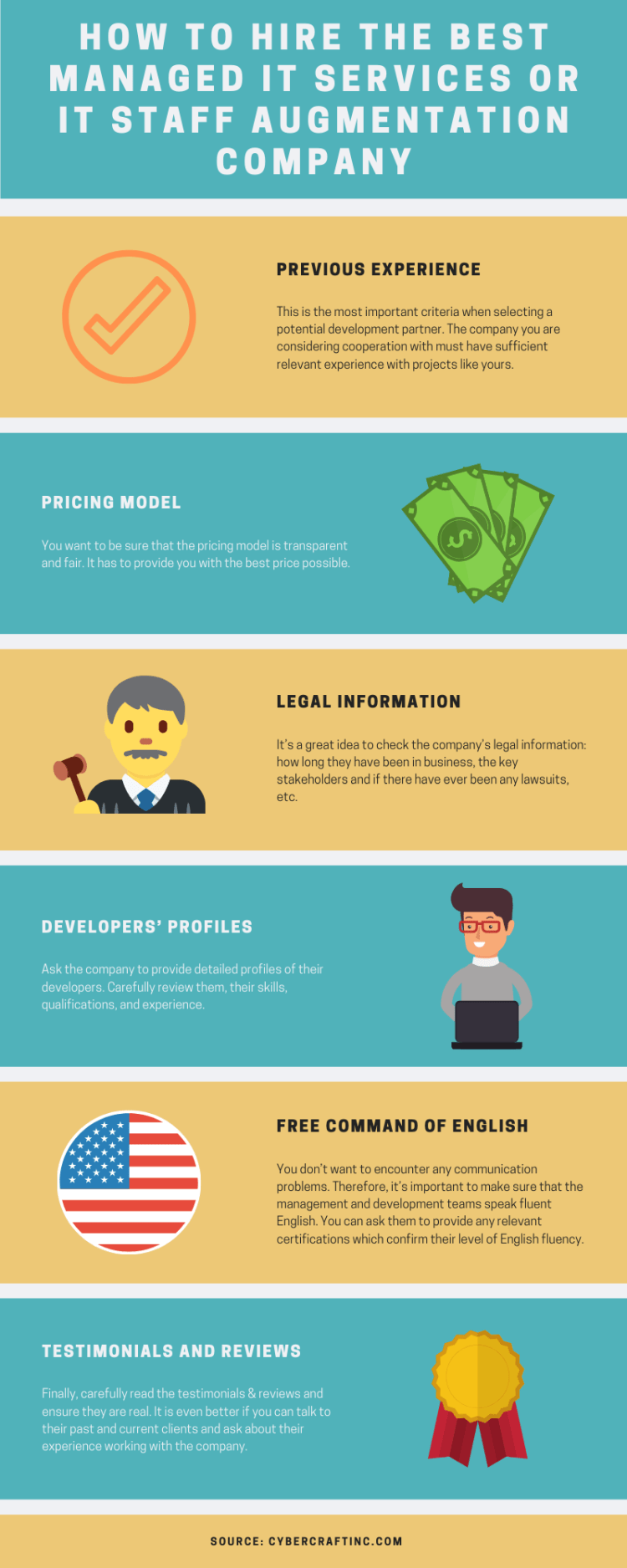
- Previous experience. This is the most important criteria when selecting a potential development partner. The company you are considering cooperation with must have sufficient relevant experience with projects like yours.
- Pricing model. You want to be sure that the pricing model is transparent and fair. It has to provide you with the best price possible.
- Legal information. It’s a great idea to check the company’s legal information: how long they have been in business, the key stakeholders and if there have ever been any lawsuits, etc.
- Developers’ profiles. Ask the company to provide detailed profiles of their developers. Carefully review them, their skills, qualifications, and experience.
- Free command of English. You don’t want to encounter any communication problems. Therefore, it’s important to make sure that the management and development teams speak fluent English. You can ask them to provide any relevant certifications which confirm their level of English fluency.
- Testimonials and Reviews. Finally, carefully read the testimonials & reviews and ensure they are real. It is even better if you can talk to their past and current clients and ask about their experience working with the company.
Of course, there might be many other factors to take into account. In the end, everything depends on your specific situations and which criteria are the most important to you.
Conclusion
Managed IT services and staff augmentation are currently the two most popular software development outsourcing models out there. Each presents its own advantages, disadvantages & risks. If you need more control and responsibility and you have the necessary resources to manage a development team then staff augmentation is definitely the right choice. Otherwise, if you wish to delegate all of the work to a development company then managed services are the right choice.




